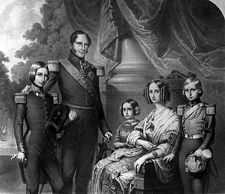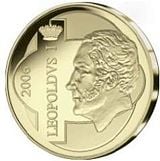Leopold I of Belgium
Template:Infobox Belgian Royalty
Leopold I (Leopold George Christian Frederick (in German Leopold Georg Christian Friedrich) Prince of Saxe-Coburg-Saalfeld, later Prince of Saxe-Coburg and Gotha, Duke of Saxony) (16 December 1790 – 10 December 1865) was from 21 July 1831 the first King of the Belgians. He was the founder of the Belgian line of the House of Saxe-Coburg-Gotha. His children included Leopold II of Belgium and Empress Carlota of Mexico.
He was born in Coburg and died in Laeken.
Early life
He was the youngest son of Franz Frederick Anton, Duke of Saxe-Coburg-Saalfeld and Countess Augusta Reuss-Ebersdorf, and later became a prince of Saxe-Coburg and Gotha after the territorial swap by his father of Ehrenburg Castle in the Bavarian town of Coburg. He was also an uncle of Queen Victoria of the United Kingdom.
In 1795, as a mere child, Leopold was appointed colonel of the Izmaylovsky Imperial Regiment in Russia. Seven years later he became a major general. When Napoleonic troops occupied the Duchy of Saxe-Coburg in 1806 Leopold went to Paris. Napoléon offered him the position of adjutant, but he refused. Instead he took up a military career in the Imperial Russian cavalry. He campaigned against Napoléon, and distinguished himself at the Battle of Kulm at the head of his cuirassier division. In 1815, Leopold reached the rank of lieutenant general in the Imperial Russian Army.
In Carlton House on 2 May 1816, he married Princess Charlotte Augusta of Wales, the only legitimate child of the British Prince Regent (later King George IV of the United Kingdom) and therefore heiress to the British throne, and was created a British field-marshal and Knight of the Garter. On 5 November 1817, Princess Charlotte was delivered of a stillborn son; she herself died the following day. Had she lived, she would have become Queen of the United Kingdom on the death of her father, and Leopold presumably would have assumed the role later taken by his nephew, Prince Albert, as Prince Consort of Great Britain, and never chosen King of the Belgians. Despite Charlotte's death, the Prince Regent granted Prince Leopold the British style of Royal Highness by Order-in-Council on 6 April 1818[1]. In honor of his first wife, Leopold and Louise-Marie of France, his second wife, named their first daughter Charlotte, who would later become Empress Carlota of Mexico.
On 2 July 1829, Leopold participated in nuptials of doubtful validity (a private marriage-contract with no religious or public ceremony) with the actress Caroline Bauer, created Countess of Montgomery, a cousin of his advisor, Christian Friedrich Freiherr von Stockmar. The 'marriage' reportedly ended in 1831 and the following year he married Louise-Marie at the Château de Compiègne, in Compiègne, France, on 9 August 1832.
King of the Belgians
After Belgium asserted its independence from the Netherlands on 4 October 1830, the Belgian National Congress, considered several candidates and eventually asked Leopold to become king of the newly formed country. He was elected on 4 June and accepted and became "King of the Belgians" on 26 June 1831. He swore allegiance to the constitution in front of the Saint Jacob's Church at Coudenbergh Place in Brussels on 21 July 1831. This day became the Belgian national holiday. Jules Van Praet would become his personal secretary.
Less than two weeks later, on 2 August, the Netherlands invaded Belgium. Skirmishes continued for eight years, but in 1839 the two countries signed the Treaty of London establishing Belgium's independence.
With the opening of the railway line between Brussels and Mechelen on 5 May 1835, one of King Leopold's fondest hopes—to build the first railway in continental Europe—became a reality.
Template:Infobox Monarch styles
In 1840, Leopold arranged the marriage of his niece, Queen Victoria, the daughter of his sister, Princess Victoria of Saxe-Coburg-Saalfeld, to his nephew, Prince Albert of Saxe-Coburg and Gotha, son of his brother, Ernst I, Duke of Saxe-Coburg and Gotha. Even before she succeeded to the throne, Leopold had been advising the then-Princess Victoria by letter, and after her accession, he was one of the great influences on her in the early days of her monarchy.
In 1842, Leopold tried unsuccessfully to pass laws to regulate female and child labor. A wave of revolutions passed over Europe after the deposition of King Louis-Philippe from the French throne in 1848. Belgium remained neutral, mainly because of Leopold's diplomatic efforts.
He was the 649th Knight of the Order of the Garter in 1816, the 947th Knight of the Order of the Golden Fleece in Spain in 1835 and the 35th Grand Cross of the Order of the Tower and Sword.
On 11 October 1850, Leopold again lost a young wife, as Queen Louise-Marie died of tuberculosis at age 38. At 11:45 am on 10 December 1865, the king died in Laken. He lies buried in the Royal vault at the Church of Our Lady, Laken Cemetery, Brussels, Belgium.
Ancestry
| Leopold I of Belgium | Father: Francis, Duke of Saxe-Coburg-Saalfeld |
Paternal Grandfather: Ernest Frederick, Duke of Saxe-Coburg-Saalfeld |
Paternal Great-grandfather: Francis Josias, Duke of Saxe-Coburg-Saalfeld |
| Paternal Great-grandmother: Anna Sophie, Princess of Schwarzburg-Rudolstadt | |||
| Paternal Grandmother: Sophia Antonia of Brunswick-Wolfenbüttel |
Paternal Great-grandfather: Ferdinand Albert II of Brunswick-Wolfenbüttel | ||
| Paternal Great-grandmother: Antoinetta Amelia of Wolfenbüttel-Blackenburg | |||
| Mother: Augusta Reuss-Ebersdorf |
Maternal Grandfather: Count Heinrich XXIV Reuss of Ebersdorf and Lobenstein |
Maternal Great-grandfather: Heinrich XXIII Reuss of Ebersdorf and Lobenstein | |
| Maternal Great-grandmother: Sophie Theodora of Castell-Remlingen | |||
| Maternal Grandmother: Karoline Ernestine of Erbach-Schönberg |
Maternal Great-grandfather: Georg August of Erbach-Schönberg | ||
| Maternal Great-grandmother: Ferdinande Henriette of Stolberg-Gedern |
Patrilineal descent
Descent before Conrad the Great is taken from [1] and may be inaccurate.
House of Wettin
- Burkhard I, Duke of Thuringia, d. 870
- Burchard, Duke of Thuringia, 836 - 908
- (possibly) Burkhard III of Grabfeldgau, 866 - 913
- Dedi I, Count of Hessegau, 896 - 957
- (probably) Dietrich I of Wettin, d. 976
- (possibly) Dedi II, Count of Hessegau, 946 - 1009
- Dietrich II of Wettin, 991 - 1034
- Thimo I of Wettin, d. 1099
- Thimo II the Brave, Count of Wettin, d. 1118
- Conrad, Margrave of Meissen, 1098 - 1157
- Otto II, Margrave of Meissen, 1125 - 1190
- Dietrich I, Margrave of Meissen, 1162 - 1221
- Henry III, Margrave of Meissen, c. 1215 - 1288
- Albert II, Margrave of Meissen, 1240 - 1314
- Frederick I, Margrave of Meissen, 1257 - 1323
- Frederick II, Margrave of Meissen, 1310 - 1349
- Frederick III, Landgrave of Thuringia, 1332 - 1381
- Frederick I, Elector of Saxony, 1370 - 1428
- Frederick II, Elector of Saxony, 1412 - 1464
- Ernest, Elector of Saxony, 1441 - 1486
- John, Elector of Saxony, 1468 - 1532
- John Frederick I, Elector of Saxony, 1503 - 1554
- Johann Wilhelm, Duke of Saxe-Weimar, 1530 - 1573
- John II, Duke of Saxe-Weimar, 1570 - 1605
- Ernest I, Duke of Saxe-Gotha, 1601 - 1675
- John Ernest IV, Duke of Saxe-Coburg-Saalfeld, 1658 - 1729
- Francis Josias, Duke of Saxe-Coburg-Saalfeld, 1697 - 1764
- Ernest Frederick, Duke of Saxe-Coburg-Saalfeld, 1724 - 1800
- Francis, Duke of Saxe-Coburg-Saalfeld, 1750 - 1806
See also
- Kings of Belgium family tree
- Leopold I of Belgium has left such a legacy behind that he was selected as a motive for a very recent commemorative coin: the 12.50 euro 175th Anniversary of the Belgian Dynasty Coin. The obverse shows his portrait facing left.
- Crown Council of Belgium
- Louis-Joseph Seutin (1793-1862), personal doctor.
Sources
| House of Saxe-Coburg and Gotha Cadet Branch of the House of Wettin Born: 16 December 1790; Died: 10 December 1865 | ||
|---|---|---|
| Regnal Titles
| ||
| New Title | King of the Belgians 1831 – 1865 |
Succeeded by: Leopold II |
External links
- Royal House of Belgium
- Ducal House of Saxe-Coburg-Gotha
- Royal House of Great-Britain
- Royal House of France
ar:ليوبولد الأول من بلجيكا ast:Leopoldu I de Bélxica br:Leopold Iañ a Velgia bg:Леополд I (Белгия) ca:Leopold I de Bèlgica cs:Leopold I. Belgický de:Leopold I. (Belgien) et:Léopold I el:Λεοπόλδος Α΄ του Βελγίου es:Leopoldo I de Bélgica fr:Léopold Ier de Belgique ko:벨기에의 레오폴 1세 hr:Leopold I. Belgijski id:Leopold I dari Belgia it:Leopoldo I del Belgio he:לאופולד הראשון, מלך הבלגים la:Leopoldus I (rex Belgiae) lb:Leopold I. vun der Belsch hu:I. Lipót belga király nl:Leopold I van België ja:レオポルド1世 (ベルギー王) no:Leopold I av Belgia pl:Leopold I Koburg pt:Leopoldo I da Bélgica ro:Leopold I al Belgiei ru:Леопольд I (король Бельгии) sr:Леополд I од Белгије fi:Leopold I (Belgia) sv:Leopold I av Belgien tr:I. Léopold (Belçika Kralı) wa:Yopôl Prumî d' Beldjike zh:利奥波德一世 (比利时)
Credits
New World Encyclopedia writers and editors rewrote and completed the Wikipedia article in accordance with New World Encyclopedia standards. This article abides by terms of the Creative Commons CC-by-sa 3.0 License (CC-by-sa), which may be used and disseminated with proper attribution. Credit is due under the terms of this license that can reference both the New World Encyclopedia contributors and the selfless volunteer contributors of the Wikimedia Foundation. To cite this article click here for a list of acceptable citing formats.The history of earlier contributions by wikipedians is accessible to researchers here:
The history of this article since it was imported to New World Encyclopedia:
Note: Some restrictions may apply to use of individual images which are separately licensed.


